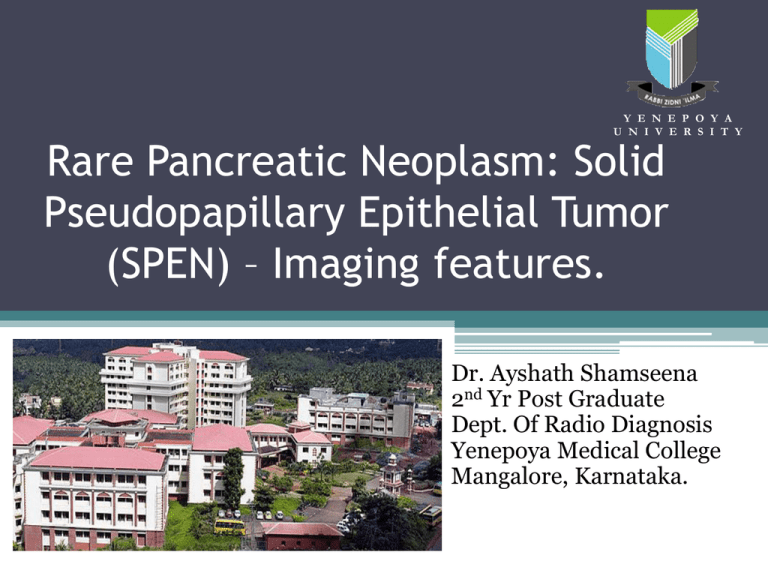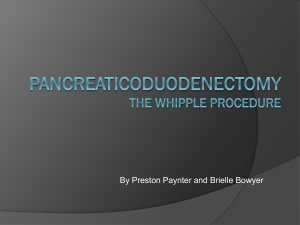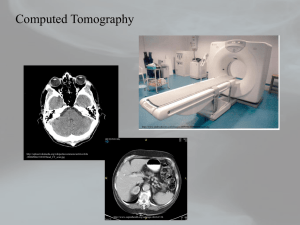
Y E N E P O Y A
U N I V E R S I T Y
Rare Pancreatic Neoplasm: Solid
Pseudopapillary Epithelial Tumor
(SPEN) – Imaging features.
Dr. Ayshath Shamseena
2nd Yr Post Graduate
Dept. Of Radio Diagnosis
Yenepoya Medical College
Mangalore, Karnataka.
Aim
• To describe the imaging features of solid pseudopapillary
epithelial neoplasm of pancreas on ultrasound and
contrast enhanced computed tomography.
Materials and Methods
• Two female patients aged 16 and 25 year who presented
with vague abdominal pain were included in the study.
• Ultrasound was done with GE Voluson E8.
• Plain and contrast enhanced computed tomography was
done using GE 16 slice multidetector computed
tomography for further evaluation.
• Computed tomography guided fine needle aspiration
cytology was done for histopathological confirmation.
Ultrasound Images
Images a and b show a well defined solid cystic predominantly
hypoechoic lesion in relation to the pancreas.
Computed Tomography Images
Axial computed tomography images depict a well defined hypodense lesion in
relation to the head and body of pancreas with focal calcification in (a) plain and (b)
in arterial phase.
Computed tomography images in venous phase showing a heterogeneously
enhancing well defined lesion in the head and body region of pancreas – (a) axial
and (b) coronal reformatted images.
Axial computed tomography images depict a well defined hypodense lesion in
relation to the tail of pancreas in (a) plain and (b) in arterial phase.
Computed tomography images in venous phase showing a heterogeneously
enhancing well defined lesion in the tail of the pancreas – (a) axial and (b)
coronal reformatted images.
Axial plain computed tomography images during fine needle aspiration cytology
procedure.
Results
• In both cases, ultrasound demonstrated a well defined
solid cystic predominantly hypoechoic lesion in relation
to the pancreas with no significant vascularity.
• Contrast enhanced computed tomography revealed
heterogeneously enhancing well defined mixed density
lesion in the pancreas.
• Computed tomography guided fine needle aspiration
cytology confirmed the diagnosis of solid
pseudopapillary epithelial neoplasm of pancreas in both
cases.
Discussion
• Solid pseudopapillary epithelial neoplasms (SPEN) of
the pancreas are rare exocrine pancreatic tumors.(1)
• It was first described by Franz in 1959 as a “papillary
tumor of the pancreas, benign or malignant.”(1)
• Epidemiology –
▫ Rare – 1-2%
▫ Predominantly affects non-Caucasian individuals with
predilection for Asians and Afro Americans.
▫ Age – Young with peak in the 2nd and 3rd decade.
▫ Sex – Female (male:female ratio – 1:10)(2)
• Clinical Presentation –
▫ Usually asymptomatic.
▫ Occasionally may present with mass per abdomen or
vague abdominal pain.(3)
• Pathology ▫ Gross – large, well encapsulated with varying amount
of necrosis, hemorrhage and cystic change.
▫ Microscopy – two distinct types – solid and papillary.
Solid – necrosis, foamy macrophages, cholesterol
granulomas and calcifications may be seen.
Papillary – composed of fibrovascular stalk
surrounded by several layers of epithelial cells.(1)
• Imaging –
▫ Ultrasound – well defined mass consisting of solid as
well as cystic components.
▫ Multi detector Computed Tomography (MDCT) –
Large solid-cystic masses in the pancreas with
peripheral capsule formation.
Enhancing solid components and septae.
Calcification may be present in the mass.(1,5)
• Fine-needle aspiration biopsy and cytologic analysis or
excisional biopsy and histologic analysis are needed for
definitive diagnosis. (6)
Treatment and Prognosis
• The treatment of choice is surgery with complete
resection.
• In most patients, prognosis is excellent.
• However, malignant transformation has been reported.
• Metastasis may occur to the liver and peritoneum in
some rare cases.(7)
Conclusion
• Solid pseudopapillary tumors of the pancreas are a rare
but treatable pancreatic tumor most frequently seen in
young women.
• Typical appearance consists of an encapsulated mass
with varying cystic and solid components caused by
hemorrhagic degeneration; calcification and
heterogeneous enhancement of intralesional
components.
• Ultrasound and Multidetector computed tomography are
useful in the identification of such lesions and thus for a
formation of a good differential diagnosis.
References
1.
Coleman KM, Doherty MC, Bigler SA. Solid-pseudopapillary tumor of the
pancreas. Radiographics 2003; 23(6), 1644-1648. PMID: 14615569.
2.
Bostanoglu S, Otan E, Akturan S, Hamamci EO, Bostanoglu A, Gokce A, Albayrak
L. Frantz's tumor (solid pseudopapillary tumor) of the pancreas. A case report.
JOP 2009; 10(2): 209-211. PMID: 19287121.
3.
Frantz VK. Papillary tumors of the pancreas: Benign or malignant ? Tumors of the
pancreas. In: Atlas of Tumor Pathology, Section 7, Fascicles 27 and
28.Washington, DC, USA: Armed Forces Institute of Pathology, 1959:32-3.
4.
Shaikh S, Arya S, Ramadwar M, Barreto SG, Shukla PJ, Shrikhande SV. Three
cases of unusual solid pseudopapillary tumors. Can radiology and histology aid
decision-making?. JOP 2008; 9(2): 150-159. PMID: 18326922.
5.
Kamat RN, Naik LD, Joshi RM, et al: Solid pseudopapillary tumor of the pancreas.
Indian J Pathol Microbiol 51:271-273, 2008
6.
Zinner MJ, Shurbaji MS, Cameron JL. Solid and papillary epithelial neoplasms of
the pancreas. Surgery 1990; 108(3), 475-480. PMID: 2396191
7.
Madan AK, Weldon CB, Long WP, Johnson D, Raafat A. Solid and Papillary
Epithelial Neoplasm of the Pancreas. J Surg Oncol 2004; 85:193-8. [PMID
14991875]












